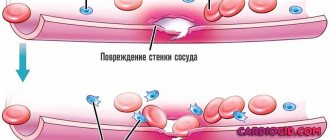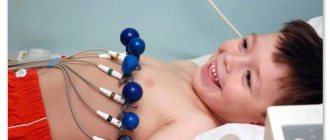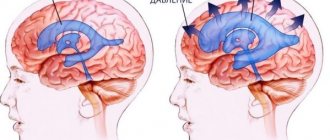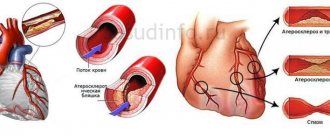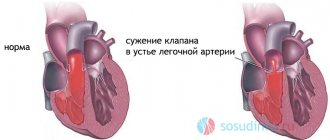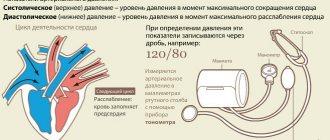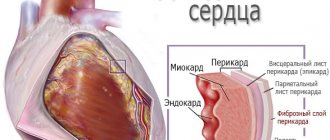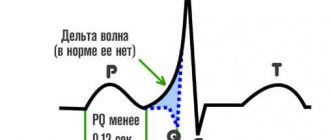Hypertension, hypertensive or hypertensive-hydrocephalic syndrome are alarming diagnoses , especially in modern environmentally unfavorable conditions and under constant stress.
Sometimes, however, doctors can explain almost any patient complaints with these terms and frighten young parents with them.
In fact, hypertension and hydrocephalus are truly complex conditions and require targeted, age-appropriate treatment, so you need to trust your health and the health of your children to a reliable, proven neurologist.
What is GGS?
In a healthy body, all systems and organs work as intended by nature, with their own characteristics and certain sequences of various processes. Sometimes it happens that some system begins to work incorrectly, this leads to the development of problems in the functioning of one or another organ or the system itself, which affects the well-being and health of a person. Hypertensive-hydrocephalic syndrome is a violation of the production of cerebrospinal fluid (CSF), its exchange and absorption with gradual accumulation in the ventricles and under the membranes of the brain. Hydrocephalus is formed, leading to hypertension - increased intracranial pressure. All together it is a hypertensive-hydrocephalic syndrome.
Hypertensive crisis
Severely elevated blood pressure (equal to or greater than systolic 180 or diastolic 110) is called a hypertensive crisis. Classified as a hypertensive emergency, depending on the absence or presence of end organ damage.
Oral medications are used to gradually lower blood pressure over 24 to 48 hours.
In a hypertensive emergency, there is evidence of direct damage to one or more organs. The most affected organs include the brain, kidneys, heart, and lungs. Causes symptoms such as confusion, drowsiness, chest pain, shortness of breath. Blood pressure must be lowered quickly to stop ongoing organ damage.
Forms of the syndrome
Hypertensive-hydrocephalic syndrome is a special condition of the brain caused by the accumulation of cerebrospinal fluid (CSF) and the subsequent increase in intracranial pressure (hypertension). Clinicians identify several types of this symptom. The main division is the open (non-communicating) and closed (communicating, obstructive) form of the disease, characterized by the characteristics of the collection of cerebrospinal fluid.
Doctors divide the open, non-obstructive form of hypertensive-hydrocephalic syndrome into three types:
- hypersecretory, determined only by the presence of choroid plexus papilloma, as well as in acute inflammatory diseases of the brain and its membranes;
- hyporesorption (aresorptive);
- hypersecretory-hyporesorption (mixed) form.
Closed, in turn, is divided into:
- monoventricular - asymmetric;
- biventricular - both ventricles and interventricular spaces are affected;
- triventricular - when the cerebral aqueduct is blocked, the lateral ventricles are dilated;
- tetraventricular - all parts of the ventricular system, interventricular foramina, and cerebral aqueduct are affected.
Mild hypertensive-hydrocephalic syndrome is an absolutely conventional, everyday term. It implies no changes in the brain due to the presence of HGS, with a slight increase in intracranial pressure and a positive potential for recovery.
Possible causes of the disease
Increased intracranial pressure as a result of the accumulation of excess cerebrospinal fluid is called hypertensive-hydrocephalic syndrome. In children and adults, this pathology can develop for many reasons:
- metabolic disease;
- neoplasms;
- hematomas in parts of the brain;
- hypertension;
- stroke;
- viral diseases - encephalitis, malaria;
- splintered injuries of the skull;
- parasitic cysts.
Establishing diagnosis
Diagnosis methods for this problem cannot always confirm the diagnosis 100%. Therefore, if in doubt, it is better to undergo the examination again or to be observed by a doctor to obtain more reliable evidence of the presence of hydrocephalic syndrome in a person. If the diagnosis is confirmed, you need to immediately begin treatment in a hospital.
Diagnosis methods:
- examination of eye vessels;
- nuclear magnetic resonance, as well as computed tomography;
- performing a puncture to measure pressure is the most reliable method.
Diagnosis of this syndrome in infants includes additional methods:
- neurosonography - ultrasound examination of the brain through the fontanelle;
- measurement of head growth dynamics.
HGS in newborns
Hypertensive-hydrocephalic syndrome in infants is a neonatology term that defines a whole set of indicators that characterize the possibility of suggesting an increase in intracranial pressure in a newborn as a result of the accumulation of cerebrospinal fluid in the brain. In the vast majority of cases, this problem develops in the baby while still in the womb. Its reasons may be:
- hypoxia (lack of oxygen) of the fetus;
- pathologies of child development as a result of genetic diseases, drug, alcohol or tobacco intoxication of the fetus;
- fetal injuries;
- trauma when passing through the birth canal.
The risk of a child developing HGS increases sharply in the following cases:
- early or, conversely, late birth;
- toxicosis (eclampsia and preeclampsia);
- pregnancy pathologies (placenta previa, placental abruption);
- premature discharge (more than 12 hours) of amniotic fluid;
- chronic maternal illnesses;
- viral or infectious diseases suffered by the mother during pregnancy;
- multiple pregnancy.
The presence of problems in the development of the newborn is assessed using a special technique called the Apgar scale. It considers a set of certain indicators using a point system. A child born with HGS has scores within 6 points, while an absolutely healthy newborn has 10 points.
Research
A 2020 review of several studies found that restoring vitamin D blood levels through supplementation (more than 1,000 IU per day) lowered blood pressure in people with hypertension. The results demonstrated a correlation of chronically low vitamin D levels with a high likelihood of hypertension.
There is preliminary evidence that increased calcium intake may help prevent hypertension. However, more research is needed to evaluate the optimal dose and possible side effects.
Sources
- “High Blood Pressure Fact Sheet.” CDC. 19 February 2020. Archived from the original on 6 March 2020. Retrieved 6 March 2016.
- Lackland DT, Weber MA (May 2015). “Global burden of cardiovascular disease and stroke: hypertension at the core.” The Canadian Journal of Cardiology. doi:10.1016/j.cjca.2015.01.009. PMID 25795106.
- Mendis S, Puska P, Norrving B (2011). Global atlas on cardiovascular disease prevention and control (PDF) (1st ed.). Geneva: World Health Organization in collaboration with the World Heart Federation and the World Stroke Organization. p. 38. ISBN 9789241564373. Archived (PDF) from the original on August 17, 2014.
- Hernandorena I, Duron E, Vidal JS, Hanon O (July 2017). “Treatment options and considerations for hypertensive patients to prevent dementia.” Expert Opinion on Pharmacotherapy (Review). PMID 28532183.
- Poulter NR, Prabhakaran D, Caulfield M (August 2015). "Hypertension" Lancet. doi:10.1016/s0140-6736. PMID 25832858.
- Carretero OA, Oparil S (January 2000). “Essential hypertension. Part I: definition and etiology.” Circulation. doi:10.1161/01.CIR.101.3.329. PMID 10645931.
HGS in children
Impaired circulation of cerebrospinal fluid, its accumulation in the interventricular spaces and under the membranes of the brain is called hypertensive-hydrocephalic syndrome. In babies born with this health problem, increased intracranial pressure and hydrocephalus affect not only their health and development, but also their appearance. The volume of the baby's head exceeds normal values by 1-2, and in some cases more, centimeters. Another characteristic external sign is sunken eyes and overhanging brow ridges. But HGS can be not only a congenital disease, but also acquired at an older age. For children from 3 to 12 years old, characteristic signs of HGS will be:
- morning headache;
- disorientation in space during headache attacks;
- lethargy and drowsiness;
- inattention;
- memory impairment;
- manifestation of photophobia and fear of loud sounds;
- muscle tone;
- strabismus appears.
This condition often develops after infectious or viral diseases, as well as head injuries.
Symptoms
Before moving on to the symptoms, it is better to understand what indicator is considered a deviation and at what pressure you should consult a doctor. While growing up, pressure readings will change - this is normal. Blood pressure is considered high in the following cases:
- in children 3-5 years old, high blood pressure - from 116 mm Hg. Art.;
- 6 - 9 years - from 122 mm Hg. Art.;
- 10 - 12 years - from 126 mm Hg. Art.;
- in adolescents, the indicator is increased - from 135 mm;
- juvenile hypertension - a constant indicator of 142 mm and above.
Clinical manifestations with a slight increase in the indicator do not affect well-being. There is irritability and rapid fatigue. However, if the pressure is too high, then the complaints will be as follows:
- headache and dizziness;
- heart spasms;
- increased heart rate;
- memory impairment.
Parents should promptly examine a child with frequent headaches.
Parents should pay attention to the nature of the headache. If it begins in the form of attacks, appears in the morning, and increases after physical activity, this means that hypertensive syndrome is developing. This syndrome in children is a serious condition characterized by increased intracranial pressure. The syndrome does not affect physical and psychological development, but causes deviations in behavior and well-being (sleep disturbance, uncontrolled crying, nausea and fluctuations in body temperature).
Features of hypertension in infants
In babies under one year old, normal pressure is 66/55 mm in girls, and in boys - 71/55 mm. Blood pressure is elevated when readings are from 112 mm Hg. Art. For children under 3 years of age, blood pressure levels are monitored only when necessary:
- if the child was premature;
- low baby weight at birth;
- difficult pregnancy and childbirth;
- maternal smoking during pregnancy;
- congenital heart and kidney diseases.
Often the presence of hypertension in infants is associated with kidney dysfunction (pyelonephritis, hypoplasia, tumor, failure). Clinical manifestations include rapid pulse, shortness of breath and tremor. Treatment should be aimed at both stabilizing the pressure and eliminating the underlying cause.
HGS in adults
Hypertensive-hydrocephalic syndrome is not only a problem for newborns and children. It can also develop in adults. The causes of this condition in adults can be head injuries, diseases, tumors, and large aneurysms. Hypertensive-hydrocephalic syndrome in adults manifests itself as follows:
- severe headache, recurring more and more frequently;
- systematic nausea and vomiting;
- visual disturbances;
- apathy;
- irritability;
- convulsions;
- dizziness;
- loss of consciousness;
- coma.
Secondary hypertension
Hypertension with certain additional features indicates secondary hypertension due to a specific cause. For example, Cushing's syndrome often causes obesity, glucose intolerance, moon face, a hump of fat behind the neck/shoulder (called a buffalo hump), and purple stretch marks on the abdomen.
Hyperthyroidism often causes weight loss with increased appetite, rapid heartbeat, bulging eyes, and tremors. Renal artery stenosis (RAS) may be associated with a localized abdominal process to the left or right of the midline (unilateral RAS) or in both locations (bilateral).
Coarctation of the aorta often causes decreased blood pressure in the lower extremities relative to the arms, or delayed or absent femoral artery impulses. Pheochromocytoma causes acute (“paroxysmal”) episodes of hypertension, accompanied by headache, palpitations, pale appearance, and excessive sweating.
Clinical picture
An increase in cerebrospinal fluid and its accumulation in the interventricular spaces and under the membranes of the brain leads to an increase in intracranial pressure. This condition is called hypertensive-hydrocephalic syndrome. Its signs are clearly visible during a special examination - computed tomography: expansion of cavities with cerebrospinal fluid and compression, reduction of the brain matter. It is these processes that serve as the basis for the clinical picture of HGS - headaches, nausea, visual impairment, attention, ability to process received information, apathy and irritability.
A peculiarity of the main symptom - headache in both children and adults - is its manifestation in the morning, when a person wakes up and gets out of bed. A change in body position from horizontal to vertical causes difficulty in the circulation of cerebrospinal fluid, causes an increase in intracranial pressure and, as a result, headaches. Significant increases in ICP can lead to nausea, vomiting, seizures, and even coma. Older patients report impaired memory and attentiveness, disorders of the ability to process information received in any way, which leads to problems in professional activities and at home. For infants, observing the clinical picture boils down to anxiety, crying, and the child may spit up like a fountain. The baby's sleep is disturbed, he often wakes up and is capricious. Any health problems require not self-medication, but proper diagnosis.
Diagnosis of HGS
Hypertensive-hydrocephalic syndrome is a rather complex problem in terms of diagnosis; it is difficult to establish even a preliminary diagnosis based on external signs and the patient’s medical history. The only thing is congenital hydrocephalus and, as a consequence, an increase in intracranial pressure is visualized by external signs: an increase in the size of the head, deep-set eyes, overhanging brow ridges. To make an indirect diagnosis of HGS, it is necessary to conduct a comprehensive examination:
- radiography of the skull to detect deformation of the skull bones;
- consultation with an ophthalmologist to identify swelling of the mucous disc and vascular changes;
- echoencephalography.
Accurate diagnostics that can show an increase in the volume of cerebrospinal fluid and an increase in intracranial pressure are carried out only in specialized medical institutions involved in neurosurgery. But since HGS is only a syndrome caused by some pathology or disease, it is necessary to establish it. Adequate treatment of HGS is carried out based on the treatment of the underlying disease or pathology.
Other studies
Once a diagnosis is made, healthcare providers will try to determine the underlying cause based on risk factors and other symptoms, if any. Secondary is more common in children during adolescence, with most cases caused by kidney disease.
Primary or essential hypertension is more common in adolescents and adults and has many risk factors, including obesity and familial hypertension. Laboratory tests are done to identify possible causes and to determine whether hypertension has caused damage to the heart, eyes, or kidneys.
Additional tests are ordered for diabetes and high cholesterol because these are risk factors for heart disease and require treatment.
The initial evaluation includes a complete history and physical examination. Serum creatinine is measured to assess the presence of kidney disease, which may be a cause or consequence of hypertension. Testing urine samples for protein is used as a secondary indicator of kidney disease.
An electrocardiogram (ECG) is done to check if the heart has high blood pressure. Will show whether there is thickening of the heart muscle (left ventricular hypertrophy) or whether the heart has experienced a previous minor disorder, such as a silent heart attack.
Chest X-ray or echocardiography to look for signs of heart enlargement or damage.
Consequences of HGS
Hypertensive-hydrocephalic syndrome in newborns is a dangerous condition that can lead to disability and death of the child. The development of intracranial pressure leads to damage to brain tissue or its membranes. The possible consequences of HGS are influenced by the underlying cause of hydrocephalus and cerebral hypertension. It can be quickly resolved with high-quality treatment and not cause serious consequences, or it can have a serious pathology of brain development, which in any case leads to a hopeless prognosis.
For adults, the root cause of the appearance of HGS and the potential possibility of getting rid of the cause are also important. The prognosis of HGS and its consequences will depend on the clinical picture of the underlying disease.
Prevention
Lifestyle changes are recommended before starting medication:
- maintain normal body weight for adults (body mass index 20–25 kg/m2)
- reduce dietary sodium intake to <100 mmol/day (<6 g sodium chloride, <2.4 g per day)
- engage in regular aerobic exercise such as brisk walking (≥30 minutes, most days of the week)
- limit alcohol consumption to no more than 3 units/day for men and no more than 2 units/day for women
- eat a diet rich in fruits and vegetables (at least five servings per day);
Effective lifestyle modifications reduce blood pressure as well as individual antihypertensive medications. Combinations of two or more lifestyle modifications can help achieve even better results. Reducing dietary salt intake helps.
Estimated sodium intake ≥6 g/–<3 g/day is associated with a high risk of death or serious cardiovascular disease. Periodontitis is associated with poor cardiovascular health
Treatment
Therapy of hypertensive-hydrocephalic syndrome uses an integrated approach. Treatment is prescribed by a neurologist together with a neurosurgeon and ophthalmologist. The patient is prescribed drugs that remove excess amounts of cerebrospinal fluid - special-purpose diuretics, nootropic drugs that improve cerebral circulation, sedatives. Massages and physiotherapeutic procedures are also prescribed. In extreme cases, treatment is carried out with surgery. Since the prognosis of HGS can be critical, it is necessary to take timely measures both to get rid of hydrocephalus and cerebral hypertension, and to eliminate the causes that caused them.
Hypertensive-hydrocephalic syndrome is a serious health problem for both adults and children. It can arise for various reasons and have a complex prognosis for treatment and consequences. You can’t ignore the primary signs - headaches, irritability, baby crying and moodiness. A competent examination and timely prescribed treatment will help compensate for the problem with the least pathological consequences.
Symptoms
Arterial hypertension is rarely accompanied by symptoms. It is identified through screening or when seeking medical help for an unrelated problem. Some people with hypertension report headaches (especially in the back of the head and in the morning), as well as dizziness, tinnitus (buzzing, hissing), changes in vision, and fainting. These symptoms may be due to associated anxiety rather than the high blood pressure itself.
On physical examination, hypertension may be associated with the presence of changes in the fundus observed during ophthalmoscopy. The severity of changes characteristic of hypertensive retinopathy is graded from I to IV; I and II degrees are difficult to distinguish. The severity of retinopathy correlates with the duration or severity of hypertension.

